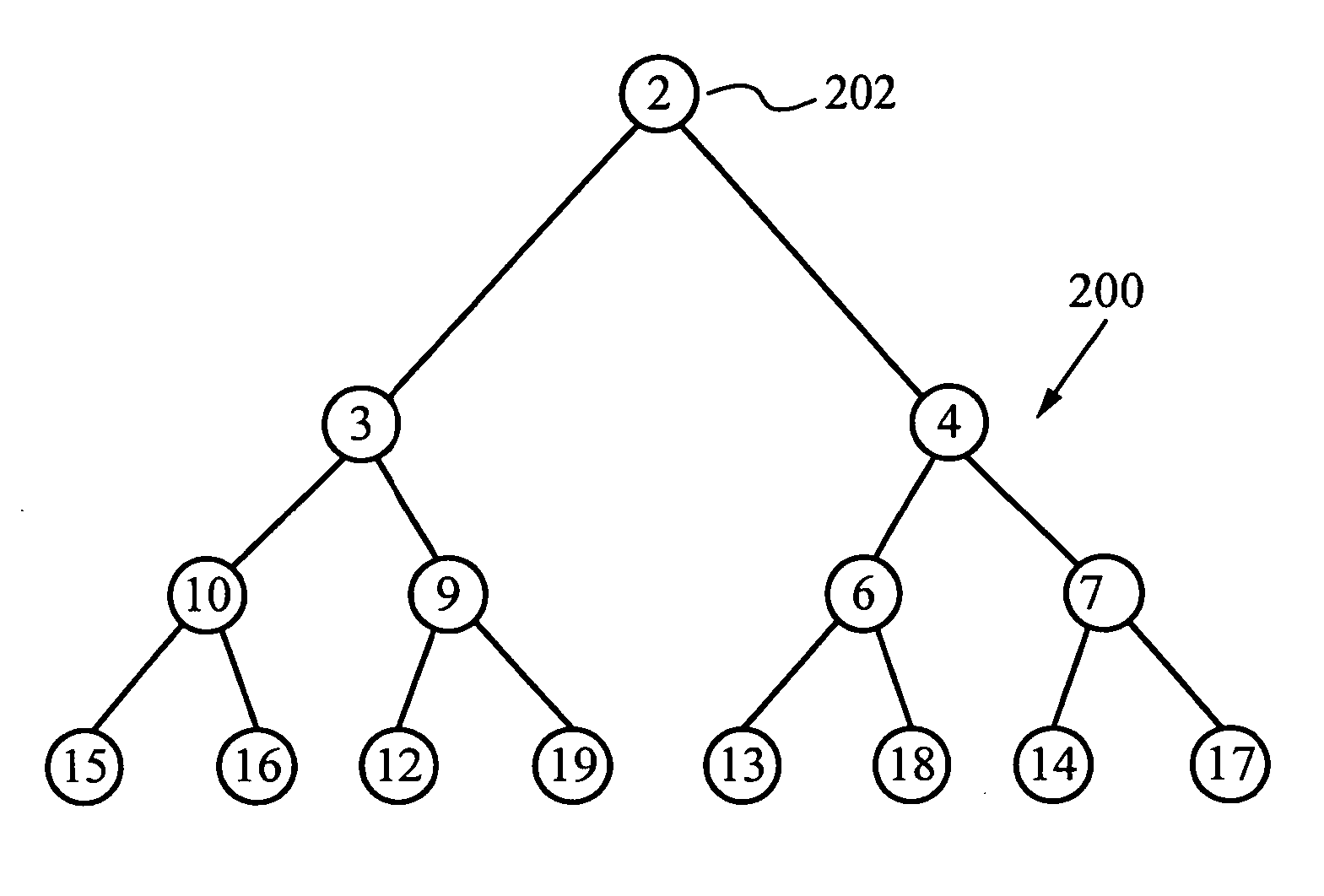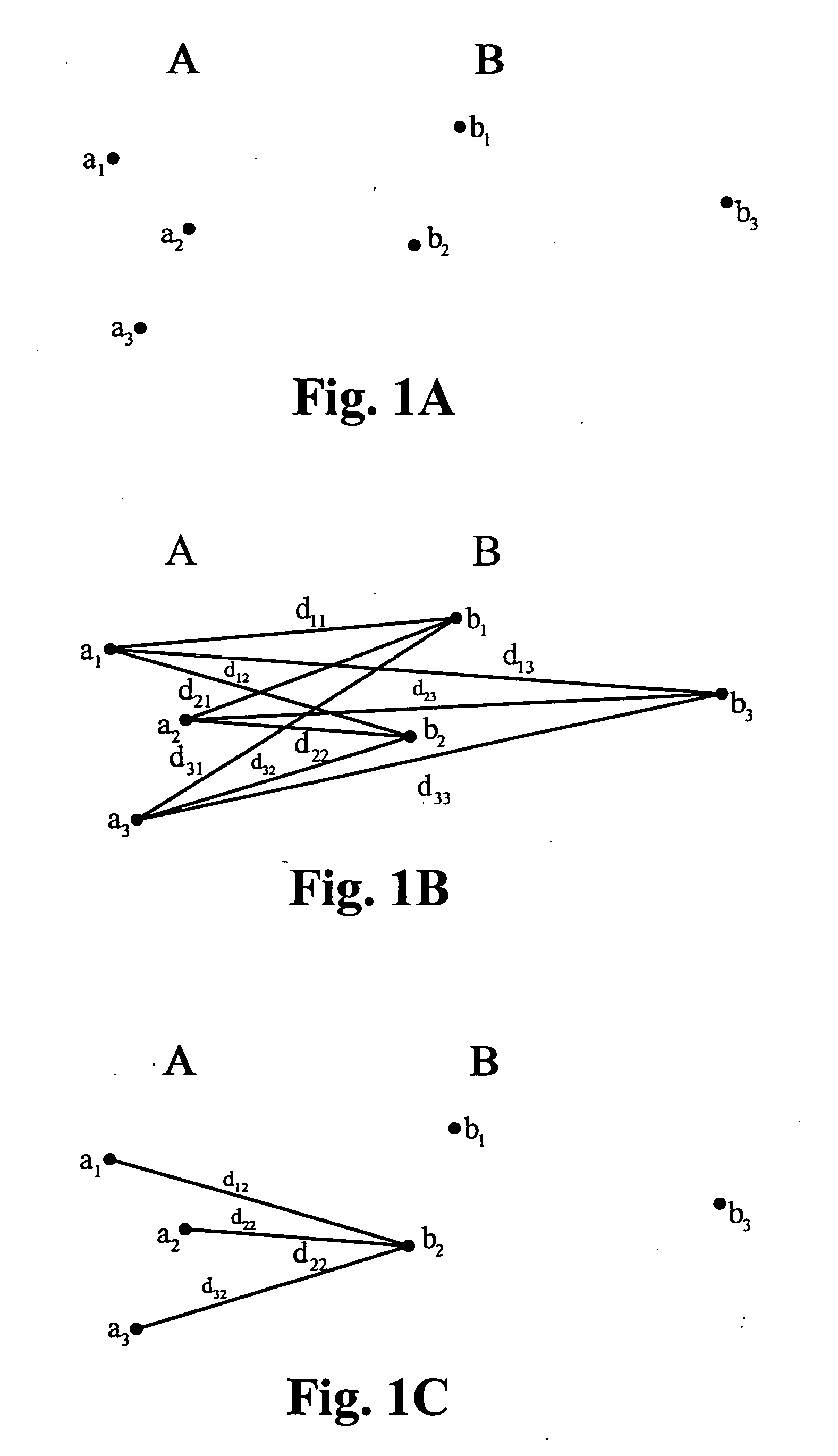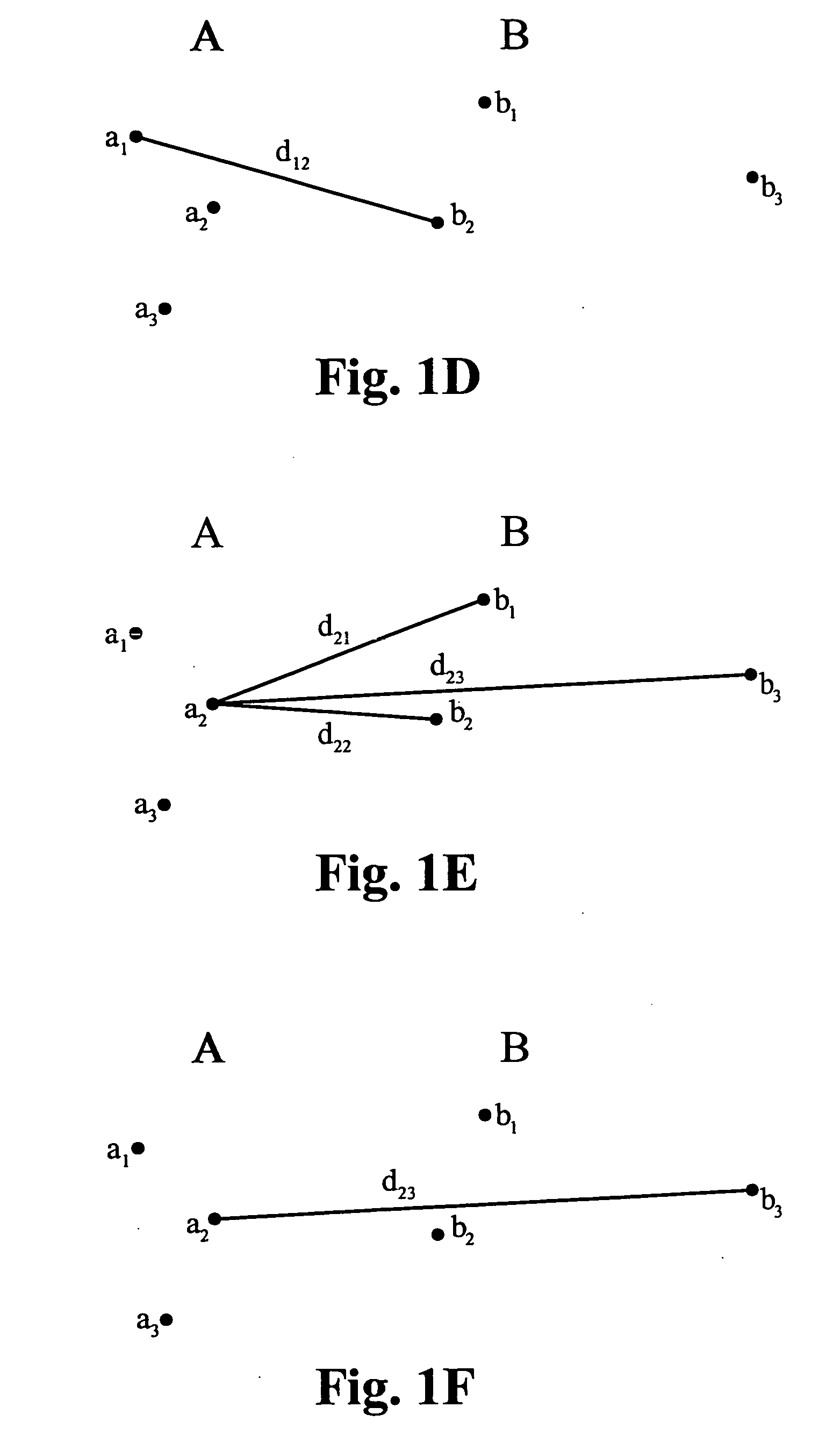[0011] In one aspect, a method of calculating a Hausdorff distance comprises computing a plurality of distances from a first set of data points to a second set of data points, inputting the plurality of distances into two 2-Dimensional heaps wherein the first 2-Dimensional heap contains a first plurality of heaps and the second 2-Dimensional heap contains a second plurality of heaps, determining a minimum within each heap in the first plurality of heaps and the second plurality of heaps, determining a first maximum within the first 2-Dimensional heap and a second maximum within the second 2-Dimensional heap and calculating the Hausdorff distance by determining the greater of the first maximum and the second maximum. Each heap within the first plurality of heaps and each heap within the second plurality of heaps are ordered using a “less than” operator. The first 2-Dimensional heap and the second 2-Dimensional heap are ordered using a “greater than” operator.
[0012] In another aspect, a system for comparing two images comprises a first image, a second image to be compared with the first image and a program to determine an earth mover's distance to compare the first image with the second image, wherein the earth mover's distance is calculated by determining the work required to move one or more earths to one or more holes wherein the one or more earths and the one or more holes correspond to colors of the first image and the second image, further wherein the earth mover's distance is calculated using Hausdorff distances which are maximum minimum distances between the first image and the second image. The Hausdorff distance is determined by using one or more 2-Dimensional heaps. The plurality of 2-Dimensional heaps each contain a plurality of heaps further wherein the plurality of heaps are ordered using a “less than” operator and the plurality of 2-Dimensional heaps are ordered using a “greater than” operator. A plurality of distances of data points between the first image and the second image are determined and stored within the plurality of heaps to calculate the Hausdorff distance. A keyword is used to determine the second image to compare. Alternatively, the second image is selected by a user. The shorter the earth mover's distance, the more similar the first image and the second image are. The first image and the second image are compared over the Internet. Alternatively, the first image and the second image are compared on a computing device selected from the group consisting of a personal computer, laptop, digital camera, digital camcorder, handheld, iPod® and home entertainment system.
[0013] In yet another aspect, a method of comparing a first image with a second image, comprises determining a Hausdorff distance using a plurality of 2-Dimensional heaps which comprises ordering a plurality of heaps within each of the plurality of 2-Dimensional heaps to determine a minimum within each of the plurality of heaps, ordering the plurality of 2-Dimensional heaps to determine a maximum within each of the plurality of 2-Dimensional heaps and calculating a maximum between the plurality of 2-Dimensional heaps and calculating an earth mover's distance using the Hausdorff distance by determining the work required to move one or more earths to one or more holes wherein the one or more earths and the one or more holes correspond to colors of the first image and the second image. The method further comprises computing a plurality of distances of data points between the first image and the second image. The method further comprises inputting the plurality of distances into the plurality heaps within each of the 2-Dimensional heaps. A keyword is used to determine the second image to compare. Alternatively, the second image is selected by a user. The shorter the earth mover's distance, the more similar the first image is to the second image. Comparing occurs via the Internet. Alternatively, comparing occurs on a computing device selected from the group consisting of a personal computer, laptop, digital camera, digital camcorder, handheld, iPod® and home entertainment system.
[0014] In another aspect, a system for locating data comprises an image, one or more sets of data and a program to search for the image wherein the program determines an earth mover's distance to compare the image with the one or more sets of data, further wherein the earth mover's distance is calculated by determining the work required to move one or more earths to one or more holes wherein the one or more earths and the one or more holes correspond to colors of the image and the one or more sets of data, further wherein the earth mover's distance is calculated using Hausdorff distances which are maximum minimum distances between the image and the one or more sets of data. The Hausdorff distance is determined using a plurality of 2-Dimensional heaps. The plurality of 2-Dimensional heaps each contain a plurality of heaps further wherein the plurality of heaps are ordered using a “less than” operator and the plurality of 2-Dimensional heaps are ordered using a “greater than” operator. A plurality of distances of data points between the image and the one or more sets of data are determined and stored within the plurality of heaps to calculate the Hausdorff distance. The one or more sets of data are selected from the group consisting of images and videos. The program uses a keyword to determine the image to compare. Alternatively, the program uses the image selected by a user to compare. The program retrieves the one or more sets of data which are similar to the image. The program lists the one or more sets of data according to similarity to the image. The smaller the earth mover's distance, the more similar the image is to the one or more sets of data. The program searches over the Internet. Alternatively, the program searches on a computing device selected from the group consisting of a personal computer, laptop, digital camera, digital camcorder, handheld, iPod® and home entertainment system.
[0015] In yet another aspect, a method of locating one or more images comprises selecting a first image to search for, comparing the first image with one or more second images, which comprises determining a Hausdorff distance using a plurality of 2-Dimensional heaps which comprises computing a plurality of distances between data points of the first image and the second image, inputting the plurality of distances into a plurality of heaps within the plurality of 2-Dimensional heaps, ordering the plurality of heaps within each of the plurality of 2-Dimensional heaps using a “less than” operator, ordering the plurality of 2-Dimensional heaps using a “greater than” operator and calculating a maximum between the plurality of 2-Dimensional heaps and calculating an earth mover's distance using the Hausdorff distance by determining the work required to move the one or more earths to the one or more holes wherein the one or more earths and the one or more holes correspond to colors of the first image and the one or more second images and retrieving the one or more second images that are similar to the first image. The method further comprises plotting the first image and the one or more second images to a color model. The color model is CIE L*a*b*. Selecting comprises entering in a keyword upon which an image matching that keyword is utilized to compare. Alternatively, selecting is performed by a user. The method further comprises listing the one or more second images according to similarity to the first image. A smaller earth mover's distance means a higher similarity between the first image and the one or more second images. Comparing and retrieving occurs via the Internet. Alternatively, comparing and retrieving occurs on a computing device selected from the group consisting of a personal computer, laptop, digital camera, digital camcorder, handheld, iPod® and home entertainment system.
[0016] In another aspect, a method of computing an earth mover's distance between a first and a second image comprises plotting the first image to a color model, plotting the second image to the color model, determining the size of one or more earths, wherein the one or more earths are derived from the first image, determining the size of one or more holes, wherein the one or more holes are derived from the second image, computing a plurality of distances of a plurality of data points within the first image to a plurality of data points within the second image, inputting the plurality of distances into two 2-Dimensional heaps wherein the first 2-Dimensional heap contains a first plurality of heaps and the second 2-Dimensional heap contains a second plurality of heaps, determining a minimum within each heap in the first plurality of heaps and the second plurality of heaps, determining a first maximum within the first 2-Dimensional heap and a second maximum within the second 2-Dimensional heap, removing the heaps from which the first maximum and the second maximum are from, calculating the Hausdorff distance by determining the greater of the first maximum and the second maximum, moving the one or more earths to the one or more holes utilizing the Hausdorff distance and determining Earth Mover's Distance based on work of moving the one or more earths to the one or more holes. The color model is CIE L*a*b*. The method further comprises repeating steps g-k until there are no more earths and no more holes remaining.
 Login to View More
Login to View More  Login to View More
Login to View More 


